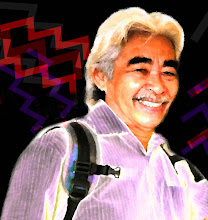If you like mangoes then you should like these slices of 'ong balem'. Both the mango and the 'balem' are from the same family i.e. mangifera. The taste can range from sweet sour to very sweet. Unlike the mango the balem fruit is very fibrous and for that matter I love to eat it. Guess it is good for the stomach and general body upkeep. Whereas the mango is known as mangifera indica, the balem is called mangifera pajang. The word 'Ong' in the Bintulu Melanau dialect means fruit, thus 'Ong Balem' - the fruit of the 'Balem' tree.
Bintulu is now in the full swing of the seasonal fruiting season which is at its peak in the months of November right till December annually. At any day now at the Bintulu tamu or jungle produce market you can see the above ' bald ' looking fruit called the 'balem' in the local Melanau dialect. The Ibans call them 'Bambangan' and among the nomadic Penan tribes, it is called 'Alim'. The going price per fruit of the above size ( about 1-1.5 kilo) is RM 1.
In my childhood years we used to joke at a bald-headed guy as 'Ong Balem'. A secret code only a few knew.
The skin of the balem fruit is thick and in a single fruit of say 1.5 kilo, half a kilo will be its skin and another half its sizeable seed. The skin is easily peeled off from the pulp or flesh and its important to follow the fibrous veins to cut it neatly and easily.
The ripe balem fruit is best taken fresh. Its thick skin are sliced into small pieces and can be eaten as salad with the local shrimp paste or belacan. Besides that the skin can also be done as pickles.
Now this tree is tall indeed. It's the balem tree at our eco-farm and its long and straight trunk reaches about 35 meters high at the top of the canopy. Lest I forget, the young leaves of the balem can be eaten raw as salad, of course with the local belacan paste. I believe this tree must be around 60 years or more.
The balem tree can be found wild in mixed dipterocarp forests but rare. It is mainly a cultivated tree in Sarawak's lowland evergreen forests like our eco-farm for instance.






















4 comments:
Kembang air liur wai..wow, can imagine the masam-ness...
that is why malaysia become a very special country...MALAYSIA BOLEH!
can i get the seeds
Напишите мне сюда, если хотите получить такую косточку:
ukrainianolga@gmail.com
Post a Comment